Great Danes, often referred to as “gentle giants,” are known not only for their impressive size and dignified demeanor but also for their stunning variety of coat colors. These majestic dogs can stand up to 32 inches at the shoulder, and their coat colors can significantly affect their appearance and, occasionally, their popularity. The American Kennel Club (AKC) recognizes several standard colors for the breed, each with its own unique charm and set of enthusiasts. This article explores seven of the most striking Great Dane colors, showcasing how these hues enhance the regal appearance of one of the largest dog breeds in the world. Whether you are a potential Great Dane owner or simply a dog lover, understanding these color variations can provide deeper insight into the breed and help in choosing a puppy that visually appeals to you.
1. Fawn
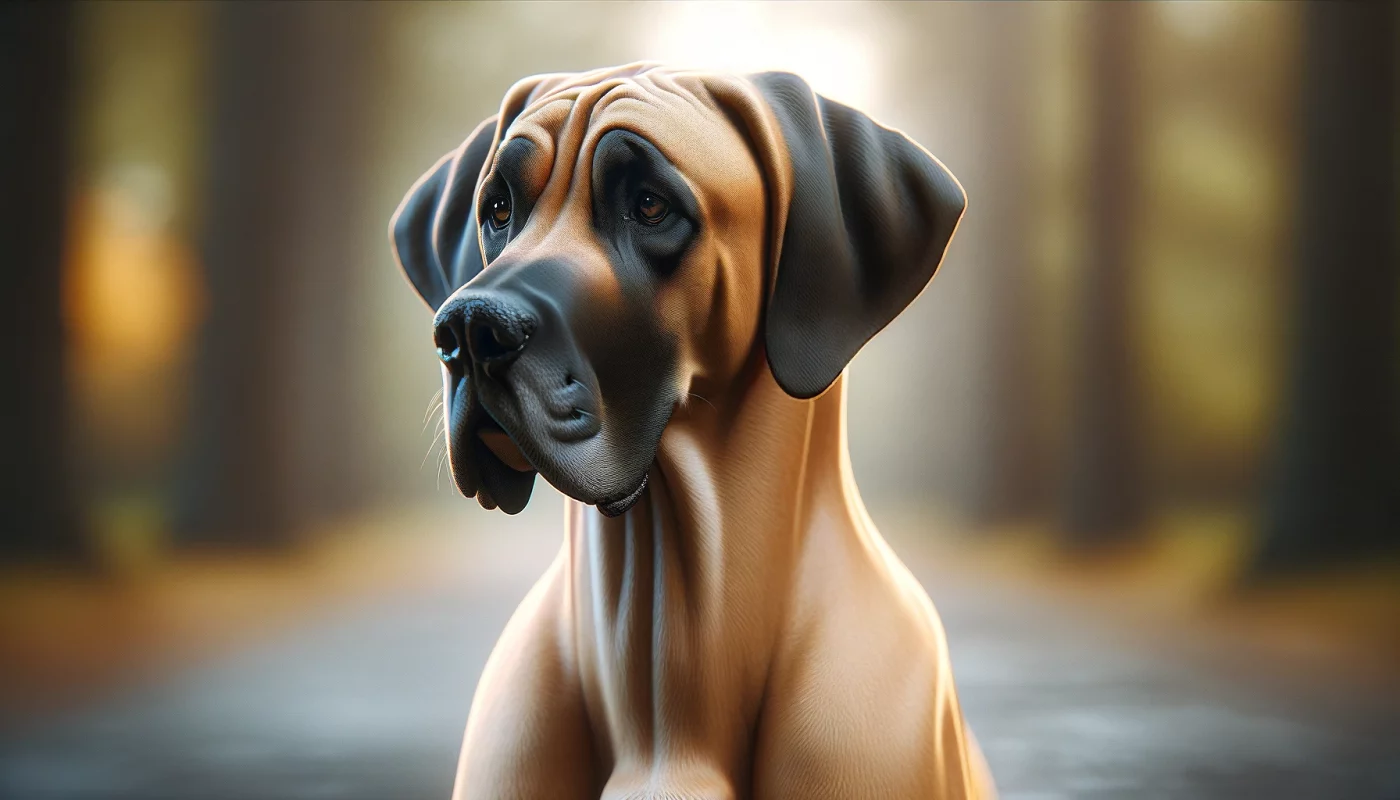
Fawn is perhaps the most recognized color in Great Danes, characterized by its golden-brown shade with a black mask on the face. This color variant provides a stunning contrast between the light body and the dark features of the muzzle, eye rims, and eyebrows, enhancing the expressive face of the Great Dane. Fawn Great Danes exhibit a warmth in color that complements their gentle nature. The coat is smooth and glossy, requiring minimal grooming but making a striking visual impact. This color’s popularity is due in part to its striking presence in shows and media, often representing the breed in various forms of advertising and film.
2. Brindle

Brindle Great Danes have a unique pattern that consists of a fawn or golden base color with strong black stripes, reminiscent of a tiger’s stripes. This intricate patterning is eye-catching and offers an exotic flair that sets these dogs apart from their solid-colored counterparts. The brindle pattern can vary significantly from light to heavily striped, creating a wide range of appearances within the color variation itself. Brindle Great Danes are often admired for their striking, bold looks and the pattern tends to highlight their muscular build and noble structure.
3. Blue
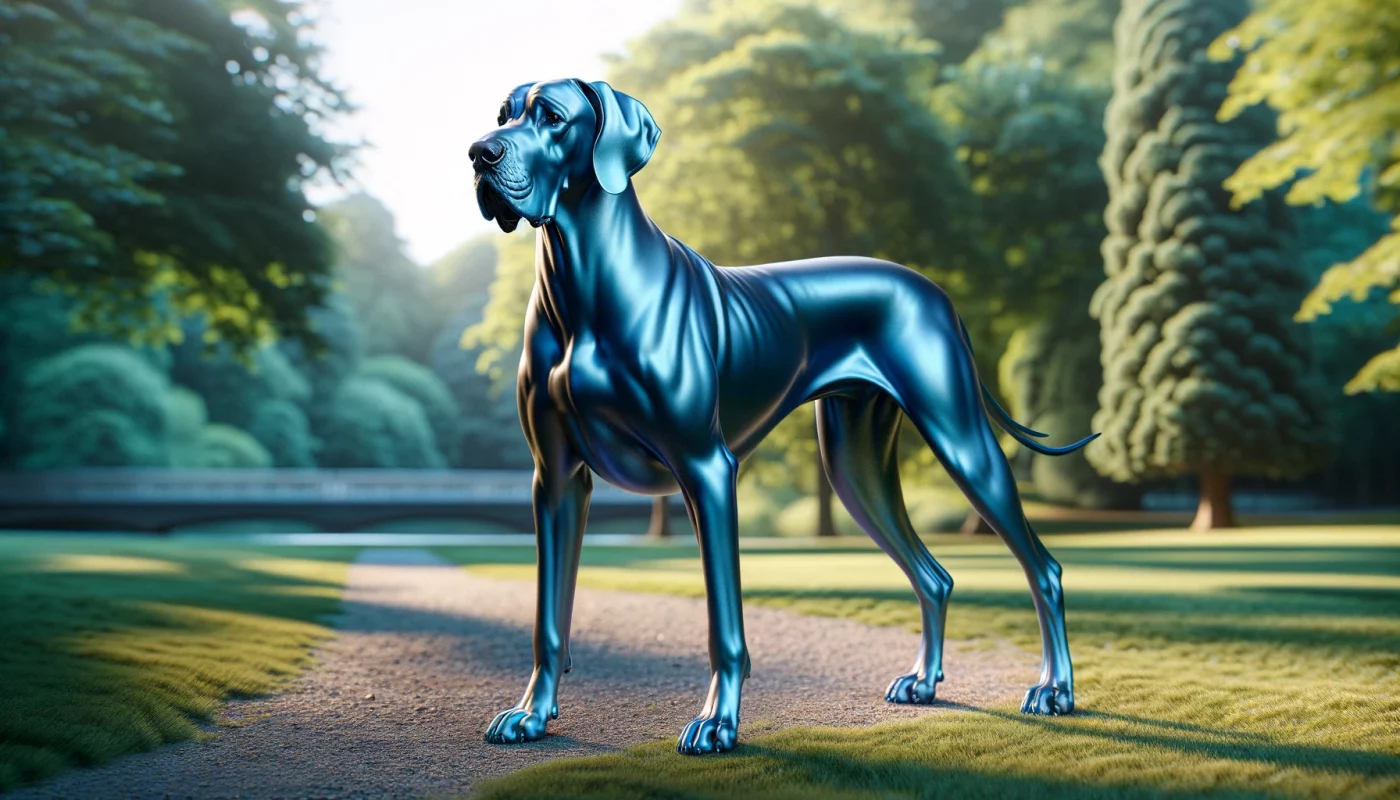
Blue Great Danes possess a sleek, steel-blue coat that captivates with its unusual hue. This color is actually a dilute black and is recognized by its even, solid tone that can range from light silver to a deep slate. The blue coat is particularly glossy, adding to the breed’s dignified presence. Blue Great Danes are often sought after for their unique color, which stands out in both the show ring and the park. Despite their standout color, these dogs maintain the breed’s hallmark friendly and gentle temperament.
4. Black
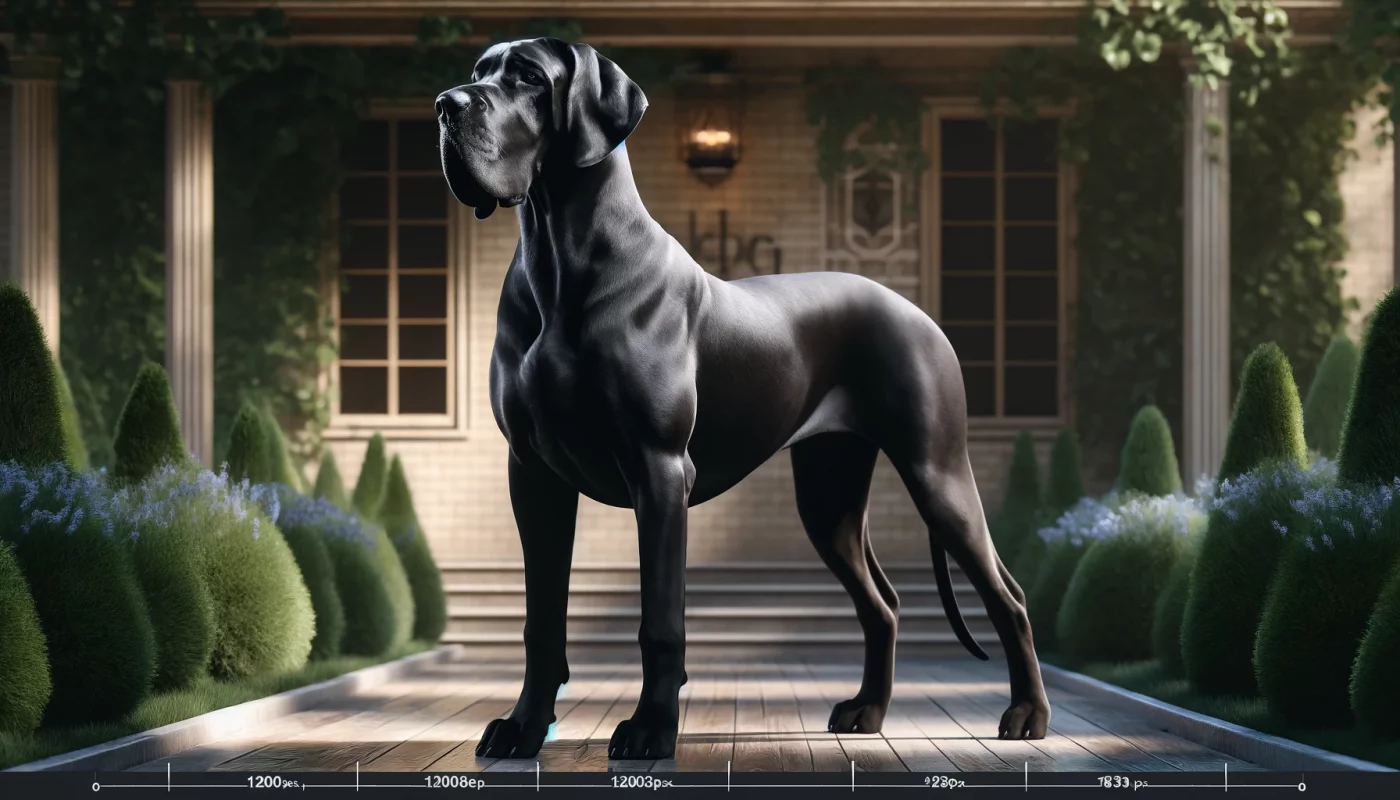
Black Great Danes are both powerful and elegant, with a jet-black coat that gleams under the sun. This solid coloring emphasizes the breed’s regal lines and smooth curves. The deep black hue enhances their impressive stature, making them look both imposing and majestic. Black is often preferred for its classic beauty and the way it highlights the Great Dane’s dignified expressions. These dogs are striking not only due to their size but also through the deep, rich color of their coat.
5. Harlequin
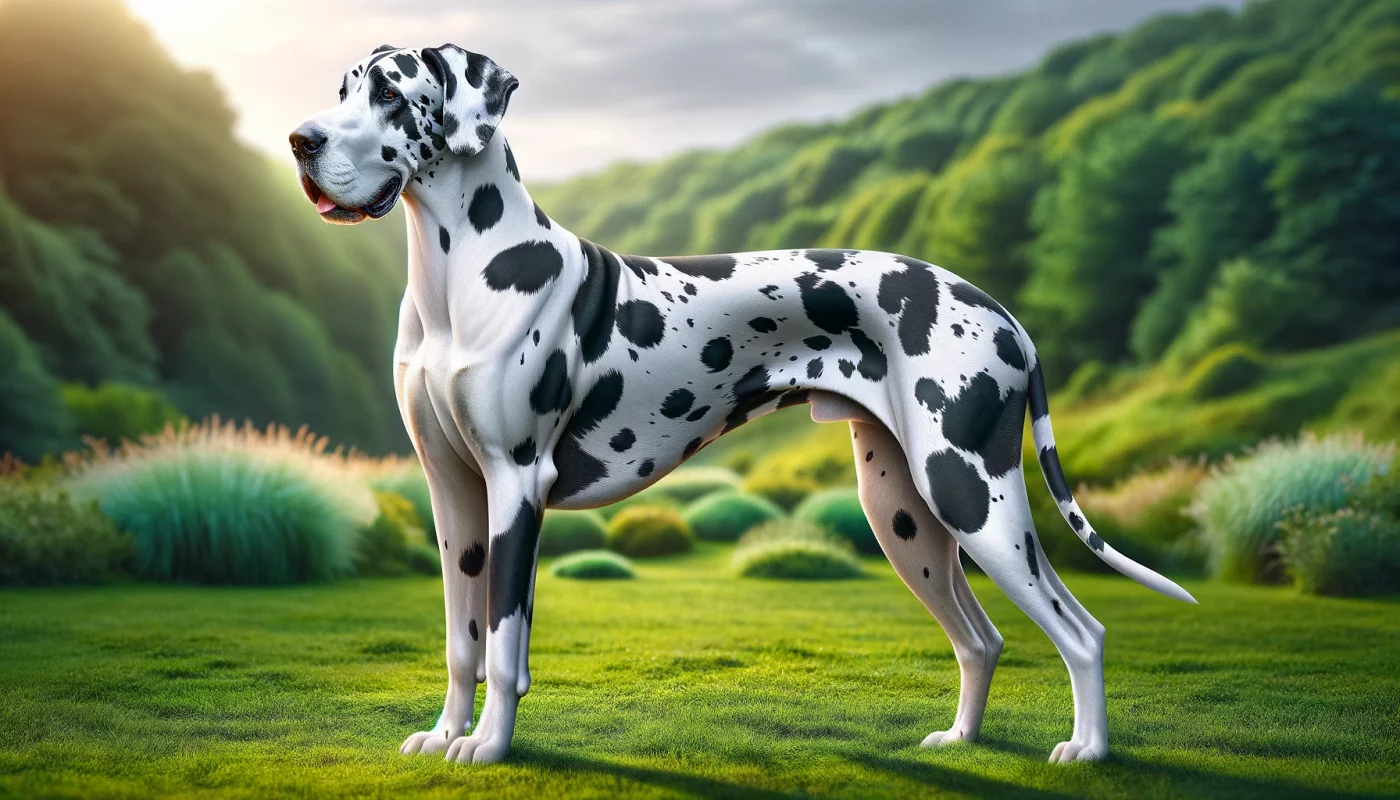
Harlequin Great Danes are particularly striking with a pattern that consists of a white base coat scattered with irregular black patches throughout. This dramatic, patchwork appearance makes the Harlequin a standout at any dog gathering. The harlequin pattern is the result of specific genetic traits, and achieving the perfect harlequin coat is a challenge that breeders strive to meet, making each Harlequin Great Dane quite unique. These dogs often catch the eye due to their distinct and unpredictable markings.
6. Mantle
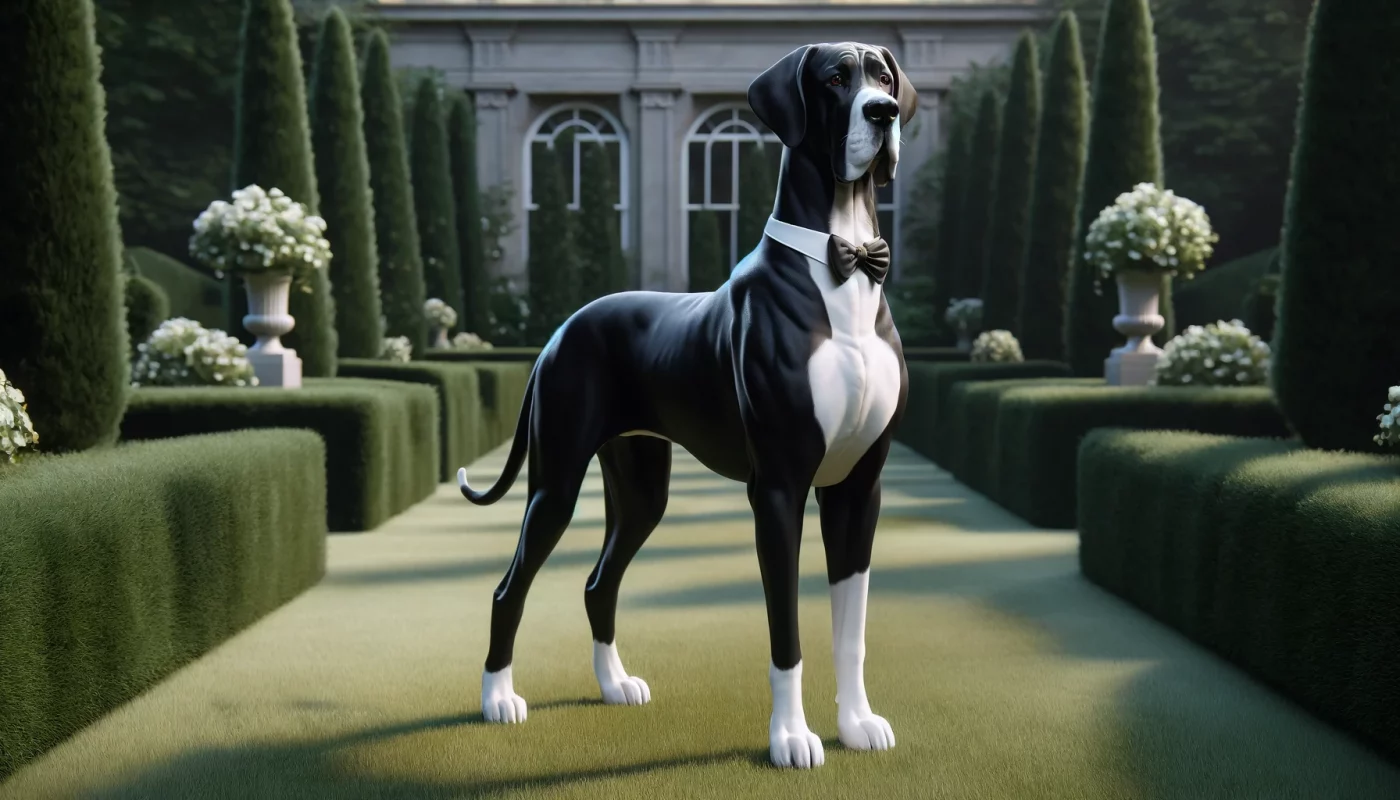
Mantle Great Danes are marked similarly to a traditional tuxedo, with a predominantly black coat that includes a white “mantle” covering the neck, chest, and part of the belly, as well as white on all or part of the legs and tail tip. This coloration makes them appear as if they are dressed for a formal event, adding to their noble bearing. The clear contrast between the black and white on their coats highlights the symmetrical beauty of the breed, making them popular among dog enthusiasts who favor a more defined and striking pattern.
7. Merle

Merle Great Danes display a mottled blend of colors which can include shades of grey, blue, and black, creating a marbled effect. This coloration is quite rare and visually interesting due to the random patterns that occur. Merle Great Danes can vary greatly in appearance even among littermates, due to the unpredictable way the merle gene expresses itself. The color can also affect the eye color, often resulting in blue or odd-colored eyes, adding to their captivating look.
The stunning color variations of the Great Dane not only contribute to the breed’s aesthetic appeal but also highlight the diverse genetics of these gentle giants. Whether cloaked in the uniform sleekness of a blue coat or the dramatic patches of a Harlequin, each Great Dane color variant has its own unique beauty and fan base. While color might be a factor in choosing a pet, prospective owners should remember that health and temperament are paramount. Each Great Dane, regardless of its coat color, requires a loving home where it can thrive as part of the family.
Frequently Asked Questions About Great Dane Colors
1. What are the standard Great Dane colors recognized by the American Kennel Club (AKC)?
The American Kennel Club recognizes six standard colors for the Great Dane. These are fawn, brindle, blue, black, harlequin, and mantle. Fawn Great Danes exhibit a yellow gold color with a black mask. Brindle Great Danes have a fawn and black cross-striped pattern. Blue Great Danes have a solid steel-blue coat. Black Great Danes are entirely black. Harlequin Great Danes are white with black patches distributed irregularly over the body, akin to a Dalmatian but with a white base coat and black patches. Mantle Great Danes look like they are wearing a black blanket over a white body, with a solid black color over the body and white on their muzzle, chest, legs, and tip of the tail. Each color has specific standards that define its ideal presentation.
2. Are there any rare colors in Great Danes?
Rare colors in Great Danes include colors like merle, fawnequin, and blue brindle, which are not recognized by major kennel clubs like the AKC for show purposes but may appear due to genetic variations. Merle Great Danes have a grey, blue, or reddish background with darker spots or patches. Fawnequin is a variation of the harlequin where the base color is fawn instead of white. Blue brindle Great Danes have a blueish hue mixed with the typical brindle pattern. These colors are often fascinating to enthusiasts but may come with various health issues related to their color genes, such as increased susceptibility to deafness or skin problems.
3. Can Great Dane colors affect their health?
Yes, certain colors in Great Danes can be linked to specific health issues. For example, dogs with the merle color pattern may be at a higher risk for genetic disorders such as deafness and eye defects. This is because the merle gene can affect pigment production that plays a crucial role in the development of the ears and eyes. Harlequin Great Danes, which require the presence of the merle gene to produce their distinctive coat pattern, can also be susceptible to these issues. Prospective owners should ensure that merle and harlequin Great Danes are health screened appropriately for these conditions.
4. Is the color of a Great Dane important when choosing a pet?
While the color of a Great Dane might be important for aesthetic preferences or show requirements, it does not generally affect the dog’s personality or suitability as a family pet. Choosing a Great Dane should primarily be based on their health, temperament, and how well the dog fits with your living situation and lifestyle. It’s important to focus on finding a reputable breeder who conducts health screenings and breeds for good temperament and health over specific color traits.
5. How do I care for a Great Dane with a light-colored coat?
Caring for a Great Dane with a light-colored coat, such as fawn or harlequin, involves some specific considerations to maintain their coat’s appearance and health. Light-colored coats can show dirt more clearly, so regular bathing and grooming are necessary to keep the coat clean and shiny. Additionally, light-colored dogs are more susceptible to sunburn. When spending time outdoors, particularly in sunny weather, it’s essential to provide shade and consider the use of pet-safe sunscreen on exposed parts of the body like the nose and ears. Regular grooming sessions also provide the opportunity to check for skin issues, which can be prevalent in lighter-skinned animals.
6. Do Great Dane puppies change color as they grow?
Great Dane puppies can sometimes change color as they mature. For instance, puppies born with a blue coat can lighten as they age, and harlequin puppies may see a shift in the placement and size of their black patches. However, the fundamental color will generally remain the same. It’s important to note that the intensity and exact shade may evolve as the dog grows, so a slight change in appearance should not be cause for concern. Regular check-ups with a veterinarian will ensure that any significant changes in coat or skin condition are monitored.
7. What is the most popular Great Dane color?
The most popular Great Dane color is often subjective and can vary depending on regional preferences and trends. Historically, fawn and black have been among the most commonly sought-after colors due to their classic appearance and the fact that they are standard colors recognized in show rings. Fawn Great Danes with a striking black mask present a traditional look that many owners and breeders admire, while black Great Danes offer a sleek and elegant appearance that is also highly favored.
8. Are there any color restrictions for Great Danes in dog shows?
In competitive dog shows, particularly those sanctioned by the AKC, there are specific color standards and restrictions for Great Danes. Only the standard colors—fawn, brindle, blue, black, harlequin, and mantle—are eligible for conformation shows. Non-standard colors, such as merle or solid white, are disqualified from competing in these events. These standards help maintain breed integrity and ensure that the physical traits of Great Danes, including coat color, adhere to the breed standard that has been established over many years.
9. How does genetics play a role in the coat color of Great Danes?
Genetics plays a crucial role in determining the coat color of Great Danes. Each coat color is associated with specific genes, which are inherited from the puppy’s parents. For example, the black color in Great Danes is dominant, meaning that it only requires one gene to be expressed. Conversely, the blue coat color results from a recessive gene, meaning a puppy needs to inherit the blue gene from both parents to exhibit this coat color. Understanding the basics of genetic inheritance can help breeders predict the possible outcomes of mating specific dogs and can guide potential owners in understanding the likely appearance of their puppies.
10. Can Great Danes have different colored coats within the same litter?
Yes, it is possible for Great Dane litters to have puppies with different colored coats. This diversity can occur especially in litters where the parents carry genes for multiple colors. For example, if a harlequin Great Dane is bred with a fawn Great Dane, the litter might include puppies with harlequin, merle, fawn, and even white coats depending on the genetic contributions of each parent. Such variations make each litter unique and can lead to a delightful variety of appearances within a single group of siblings.
 Toledo, United States.
Toledo, United States.